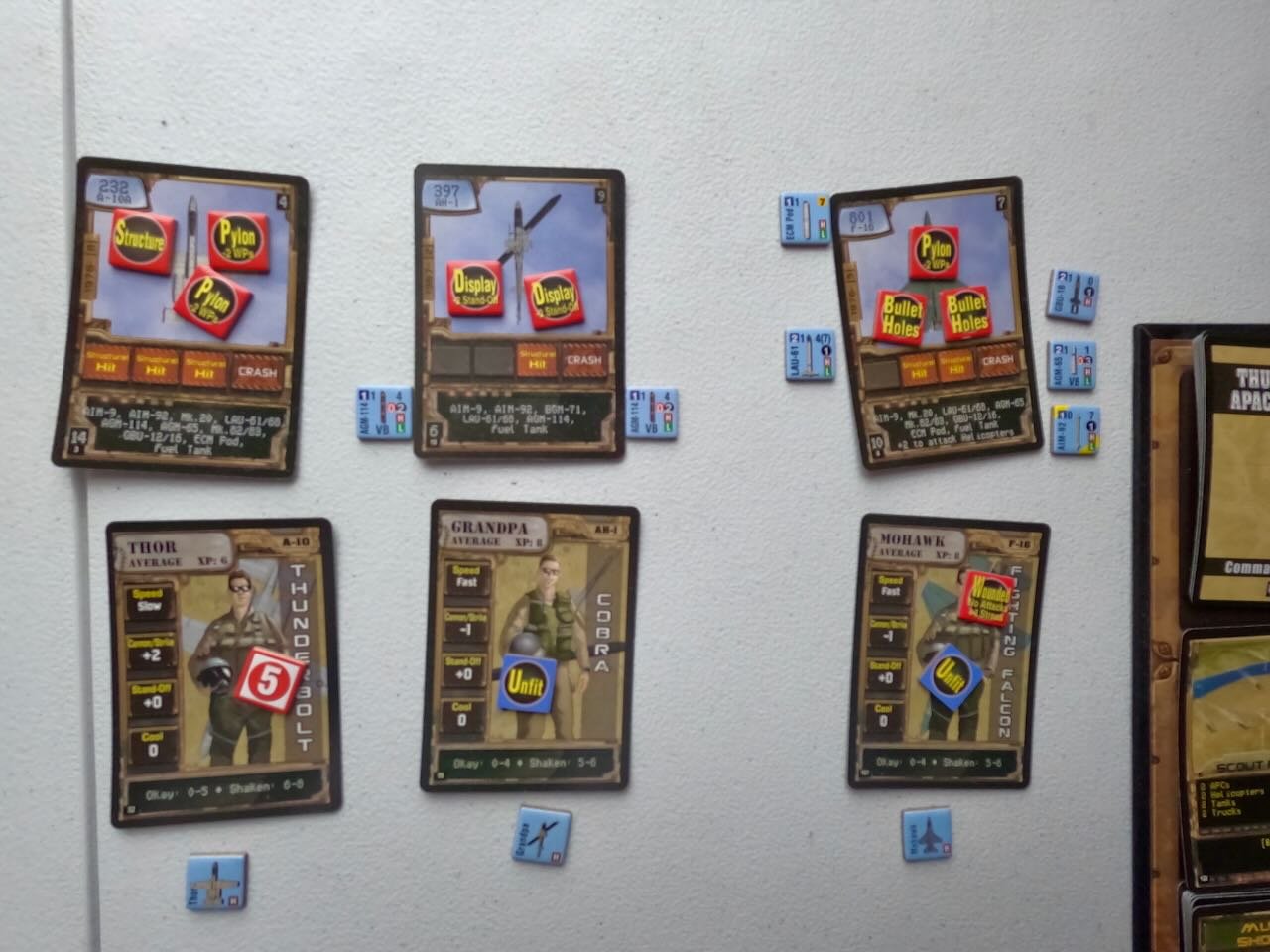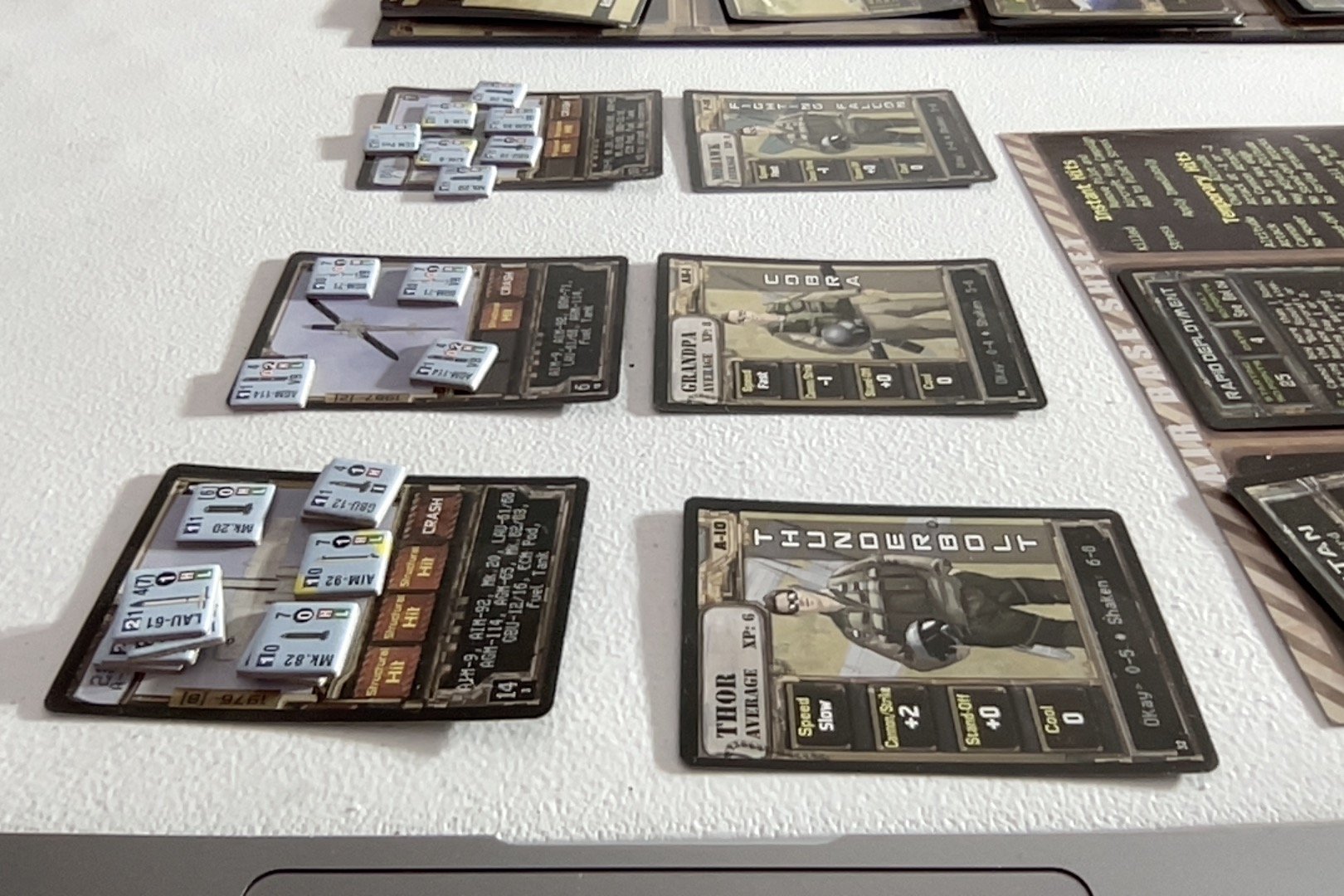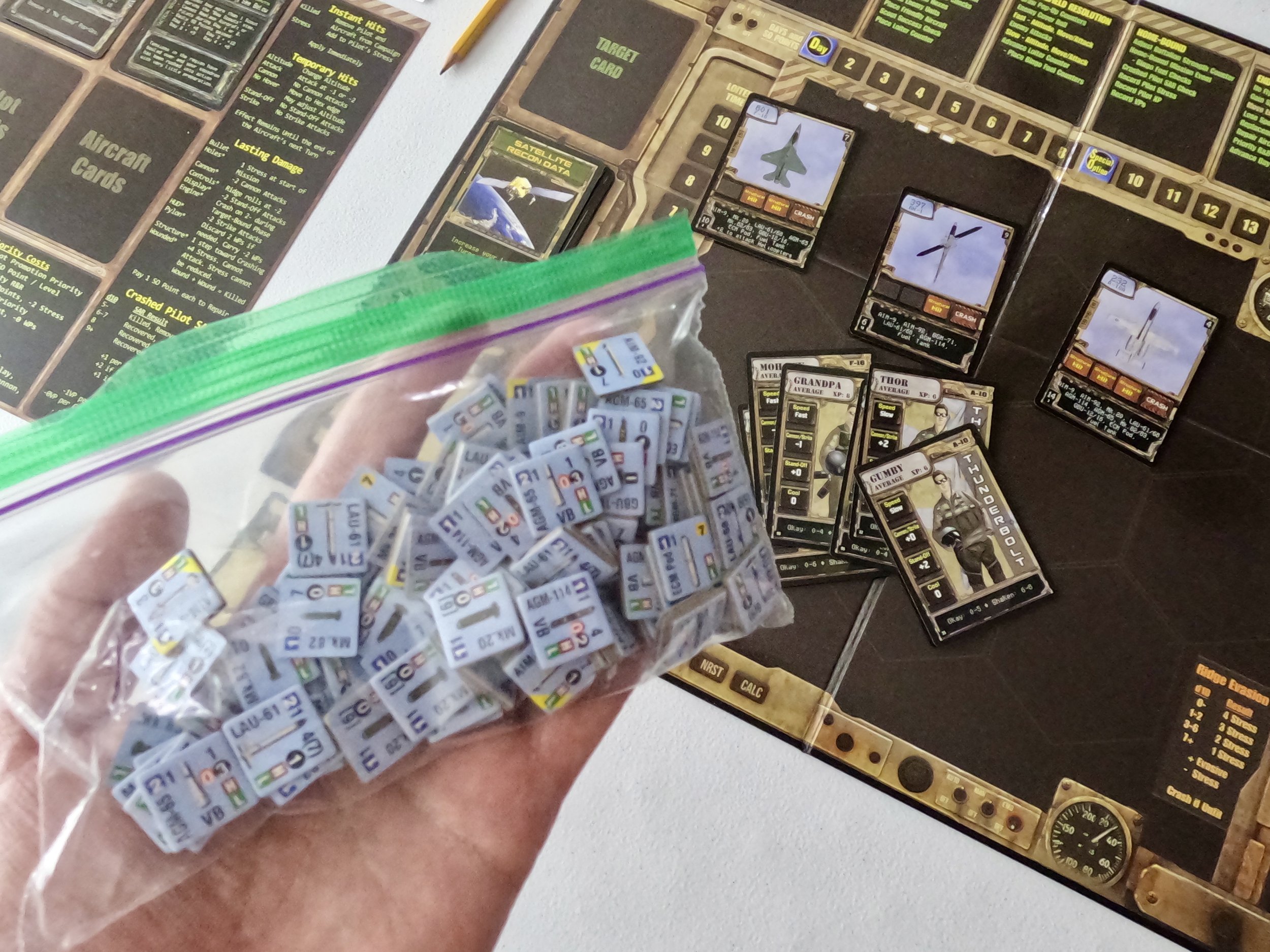Learning Thunderbolt Apache Leader: A Hapless Commander’s Journal, Pt. 4
Thunderbolt Apache Leader learning journal: My butt stinks and I think I popped a blood vessel in my eye. I’m deep into this thing.
I packed the game away after my first-ever play, looked at the box for a few minutes, then took it all back out again for a second play. Following is a collection of notes and observations on my sophomore experience.
Setup: A random draw presents me with a Cut-Off situation in Iraq. I scour the cards to find the name of who’s responsible for letting a whole-ass airbase get encircled. As usual, there’s no accountability, just rigid parameters: I’m getting most of my Special Options points up front and there are very few ways to get any more. I’ve got five days to punch a hole in the approaching enemy forces that’s big enough to reopen supply lines.
Let’s Try it Again from the Top, But With More Killing This Time, Work With Me, People, Work With Me: During my rookie mission I fielded a tiny squadron and sent them all at one target for the first few days to make game management simpler and just focus on mechanics. This time I want to have more craft that I can combine for separate strikes starting on Day 1. I end up with five: a Harrier, an F-16, an A-10A, and two AH-64s.
I want to commit Day 1 just to strikes on the enemy’s front-line assault elements: Degrade their ability to project force, then practice equipping missions that reach support and command elements in the rear range band — exotic regions I never saw during my inaugural game.
Looks like this scenario will penalize me for using craft or pilot replacement options. Looks like the only way to earn more SO points — there is no daily income in this episode — is to knock the hell out of stuff. You want resources? Let’s see some blowed-up stuff. The enemy’s hand is already closing around your windpipe.
Beginner’s Strategy Heuristics: To simplify the strategic puzzle, I’m carrying over the basic approach I settled on during my first game: Low and fast. My Day 1 crew is comprised entirely of pilots with the Fast ability (they get to fire before enemy units do). I don’t care if they’re good at other things, just give me the ones whose DNA helixes spell out K-I-L-L. These are the guys who you don’t turn loose anywhere but places like these, because they’ll pick off a civilian airliner or two out of restless hunger if you’re not constantly feeding them live target data.
Keeping the mission at low altitude means I can focus on zooming through selected lanes where they can do their dirty business in between ridgelines. No fancy Ridge Evasion checks for me. And no Pop-Up units (for each craft that starts a Loiter Turn at high altitude, you have to do a blind pull from a bag of Special Surprise Jerk Counters that might appear on the map). During my first game, Pop-Ups offended me to an almost pathological degree. I don’t like being interrupted. So we’re not doing any of that.
Privation, The Great Teacher: Having nearly all of the SO points given to me at once turned out to be an instructive limitation: With SO points desperately low as the mission days went on, I got a lot more familiar with each type of munition and what it does. I was setting tight budgets for each sortie and finding out how very much I could do with a little. I didn’t have to go grab my Xanax if there were damage markers on my craft; I got a lot better at picking which kinds of dings I had to deal with right away and which I could just let ride. (“Oh, waaah, your display is damaged. Just don’t shoot stuff from real far away, stupid. Get right up on ‘em, it’ll be fine.”)
Still Learning: When I teach others new games, I always remind them that they’re going to get major stuff wrong and to not be too upset about it. I got anxious enough to forget my own bromides. I was applying the Evasive ability wrong. I wasn’t applying Battalion notes correctly. I was routinely forgetting basic steps. I still got chewed to pieces, even with the little accidental advantages I gave myself through blithe incompetence. But as I re-read the fan-compiled FAQ on Boardgame Geek, I remembered that I was just one of hundreds of dudes effing stuff up, getting stuck, re-reading, and figuring it out in a distributed fraternity of souls siloed in thrill and despair.
Speaking of which: The several days I ran my first few games were a carousel of confusion and insight, joy and rage. I noticed last week my left eye looked a bit cloudy. I tell you in all candor that I think I popped a blood vessel in my eye screaming at Tex. He went down in his AH-64A, killed on impact from a SAM hit. His job was to take it out with LAU-61 rockets. It was important to clear this hex out, so I committed two rocket pods to the attack. Two chances to produce a four on a ten-sided die. He had some diabolical talent for avoiding the plainly achievable. Whatever came out of my mouth next would have been Q.E.D. in any divorce proceeding in any court in the U.S.
But I was already already divorced anyway, so fuck it. My hygiene suffered during these days. I hadn’t been happier in recent memory.
***
By Day 5, I can tell I’m en route to a failing grade: There are no more SO points, and despite getting pounded to half strength, my Day 4 mission troubles must have emboldened the armored spearhead battalion I tangled with the day previous. They’re advancing.
But I have rested pilots who I’m going to pile into these once-gleaming craft for one more run. Fuck mission ratings. Fuck victory points. It’s you and me, assholes, one last time. The damage markers on these craft are comically dense, but it’s late in the day and we have murder in our hearts.
I love this fucking game so much. I don’t rue the days of the old Colorado Springs crew when this is on the table. When the board has the glow of morning catchlight, I can’t even remember their faces. My eyes narrow as I sip some scalding coffee, look at the distribution of the new target battalion’s units over the terrain hexes and start planning attack lanes. I want for nothing.
Learning Thunderbolt Apache Leader: A Hapless Commander’s Journal, Pt. 3
Thunderbolt Apache Leader learning journal: I got my boys in the air for a fairly successful Day 1 attack, but Day 2 is looking dicey.
Mohawk’s inaugural high-altitude pass in his F-16 resulted in a cratered enemy AAA unit — that guided 1,000-lb. GBU-16 is a hell of a drug.
Then rookie mistakes set in: Mohawk wasted a cluster bomb trying to take out two tanks, then I blithely ended his movement right in the sights of an enemy chopper, which would have shot him down had I not equipped the bird with an ECM unit. Mohawk chuckled his way through several attempts at reprisal.
Thor swooped in with his A-10’s cannons to shred the chopper soon after. All this time, Grandpa was tasked with hunting a pair of command units, one of which he eliminated with a tidy volley of Hellfires. But owing more neophyte sloppiness in the commander’s chair, I’ve also exposed the craft to costly potshots from another enemy chopper and AA unit: Thor and Grandpa have accumulated Stress points and taken hits to their pylons, which compromise the amount of effective weight they can carry in ordnance.
This matters less to Thor, who still has a Wal-Mart distribution center’s worth of boom-boom slung under the wings of the A-10, but Grandpa’s little Cobra only has two big-punch munitions left and his cannon efficacy isn’t good enough to bank precious attack turns on….
As I age, the more painful the gap between complexity and desire becomes. Bouncing around between three different applications and four different source docs to harvest some sliver of Boring out of 15 different shards of Boring for some boring-ass project makes my mind claw for Elsewhere like a mouse trying not to drown in a jar.
But last night, driven by the building tickle of finally feeling all the game’s information and steps start to gel, I fought through it until I got into something resembling a flow. I was still doing stuff wrong — LOS, figuring out who can shoot and who and when and with what — still had me bouncing back and forth between the rulebook and BoardGameGeek forums every few minutes. But the mound of stats and chips was starting to take the shape of a game. And now I’m hungry and I want more. I’m finally feeling the thrill, the quiet pride and accomplishment of figuring it out.
Building odd monuments with a single viewing chair in a protean gallery of your own learning experiences is one of the things you learn to treasure as a solo gamer. I believe these little triumphs and insights enrich the inner life.
So Day 2 of the mission looms, and per the restrictions of the Rapid Deployment scenario, I can’t switch any pilots out. Just to see how it goes, I’m going to split my trio of flyers into two separate groups and see if I can effectively harass two enemy battalions.
Are ya winnin’, son? Grandpa and Mohawk barely made it back from the Day 2 foray vs. an enemy recon battalion. Thor’s Stress is pushing Shaken range even before he’s in the air. Feels irresponsible to send him out, but I’ve explained to him that this is a learning experience for all of us.
My expectations for this experiment are low: Grandpa was a mess after Day 1. He’s one more hit from crashing after failing a Ridge Evasion check that put his Stress levels close to the Unfit range. Also now there’s a Munition Shortage, so I’m trying to find a few missiles he can fire off while hovering and hopefully exit before he gets shot down, which almost feels like an inevitability. Mohawk, his craft still undamaged, will be hunting the rest of the hexes vs. an assault battalion, while Thor—whose Stress levels have also crept up dangerously—is heading after a separate target to see what he can get away with.
Quibble: I think I’m going to ignore the step where the rules say to strip damage and stress counters off of the pilot and craft cards, then log them all on the sheet during the bookkeeping steps. Why not just track them with the counters on the cards? It’s a better dashboard for me. Maybe this doesn’t work when you have bigger squadrons and more damage to track, but it feels like an efficient workaround for now.
Learning Thunderbolt Apache Leader: A Hapless Commander’s Journal, Pt. 2
Journaling my experiences learning Thunderbolt Apache Leader, a solo wargame from Dan Verssen Games
It’s about to get hot: Thor’s A-10A and Mohawk’s F-16 are poised to criss-cross the 10-hex tactical map—at low altitude and high altitude, respectively—and knock out as many surface-to-air threats as they can on their first pass. The hexes are sprinkled with 10 units from an enemy armor battalion, including tanks, anti-aircraft units and choppers.
Between them is Grandpa, hovering menacingly in his AH-1 over a hex that contains an enemy mobile command vehicle, all plump and dumb and gunless. The plan is to have Grandpa mop up these high-point targets while Thor and Mohawk swoop over ridgelines and across desert, hunting targets that can shoot back.
My armament strategy was, “A little of this, a little of that.” I used three SO points against the weight allowances of the craft. The strategy? Buy munitions that had a lot of different names: “GBU-16, you say? Oh, that sounds lovely. Let’s bring along a bit of that.”
The boys went shopping and found some stuff they liked
Which brings us to a consideration of the imaginative space where these bombs, in a split-second of game time, will fall. I’m no fan of the last few decades of the U.S.’ actual desert escapades. There doesn’t seem to be an option for even voting against them anymore. Think about it too much and you’ll crawl atop your wargame collection in despair, doused in lighter fluid, for a fiery penitence.
But since I’m secretly 12, I still can’t resist the “toys” themselves—or the games that allow a 54-year-old to go “PEW! PEW! BRRRRT!” in tactical systems with a toothsome degree of verisimilitude and no stakes outside the pebbled plastic of my Wal-Mart folding table.
But shit, you know what time it is: I wouldn’t be a bit surprised if some version of this hardware I’m playing with isn’t falling on Palestinian families right now. What one person considers an escapist shoot-em-up will be the next person’s depression spiral. Who can settle in for a night at the opera when you can hear Napoleon’s artillery rumbling at the outskirts of town?*
Immersing myself in the world of Thunderbolt Apache Leader as a private exercise takes some delicate bargaining with the imagination and the conscience. While I like games with militaries and combat, I get why people would rather play in arenas with anthropomorphic badgers building point systems on riverbanks, or trading buttons, or seeing who can make the fastest abstract bowl of noodles in a fictional restaurant. It’s an age of crisis. The theater walls and our psyches are paper-thin. The Worst of Everything is heaved from the wings directly onto center stage with volcanic fury. Play how you will, and when you can.
But back to my table and its accepted boundaries: I’m at the step where my pilots’ thumbs quiver angrily over the Fire buttons while I double-check attack rules, line of sight, altitude, target, and armament stats. Because all hell’s about to break loose. (P.S. I love this rulebook. There’s a lot of information, but it’s fastidious and procedural; crisp examples and well-chosen illustrations abound. I sense now—as I did when I first heard about it in 2012—that once the bookkeeping and engagement steps become second nature, this game will pack the perfect balance of engrossing detail and propulsive action.)
Frankly, it’s a godlike feeling and one of the most beautiful things about of the tabletop medium. The luxury of feeling the anticipation of a decision stretch in time. Seeing how it’s a node in a living story, part of a vivid diorama of tense action, partly under my control. Just maybe in a universe without an American God, one where flying sorties into Pakistani airspace is just a wacky thing that happens, and is forgotten in an afternoon.
*Every night for a year I’ve fallen asleep to the sound of Toby Longworth narrating Dan Abnett’s Warhammer 40,000 books. It’s been a long day. Time to drift off to the sounds of a hive city being shelled into fragments. To mangle the famous Josef Stalin quote: “10 million deaths is a tragedy, 100 million is hysterical.”
Learning Thunderbolt Apache Leader: A Hapless Commander’s Journal, Pt. 1
Journaling my experiences learning Thunderbolt Apache Leader, a solo wargame from Dan Verssen Games
From a production and budget standpoint, I completely get why a scrappy, independent publisher of wargames would get a couple of pilot illustrations done and then duplicate that across several characters. You switch out the name and stats and keep going because it’s not like the margins are huge in this business.
But in the early going, I find these dudes hilarious; it’s like I’m in charge of an army of hale and doughy vat-cloned yahoos who all were past winners on some military reality show called Top Jerk. (How much post-discharge therapy would you need if you woke up in quarters at 3 a.m. and three identical dudes like this were massing at your cot for some kind of coprophilic prank? These portraits are bursting with grim comedic potential.)
Genius, Divot and Pro are preparing a variety of Midwestern surprises for you
That aside: my plucky All-American homonculi and I, according to the draw of the cards, are off to Pakistan, where we face a Rapid Deployment scenario in the variable setup. Special Options points—your “money” for equipping the squadron and its fliers, among other vital functions—are at a premium. Whatever it is we’re going to do, we’ve got four mission days to do it and twelve enemy divisions to do it to.
What else do I know so far? I love the granular “Now put this here, dummy” steps in the meticulous rulebook. I’ve blown 16 of my 25 initial Special Options points on a squadron consisting of an F-16, an AH-1, an A-10A (if I can’t go BRRRRRRT on my first go, I don’t see the point of any of this) and a scout unit.
I’ve got a roster of six flyers: Mohawk, Dart, Freak, Grandpa, Thor and Gumby. All rated Average in the cockpit, even if they’re exceptionally terrifying while chewing in unison at mess behind wraparound shades. I love filling out the player log, it feels like I’m doing a TTRPG bolted onto very solid rails. I promoted none of my guys in anticipation of point expenditure on armaments. You pick out and “pay” for all your air-to-air and air-to-ground ordnance, following the aircraft data cards for which craft takes what kind of bomb or missile. I’m not worried about strategy at this point: These MFers are probably going to die. I will get sent to another post and apply their sacrifice to my continued improvement. I’ve never felt more patriotic than while typing the previous sentence.
According to the Special Condition card I pulled, I’ve got satellite recon data on my side, which will increase my Loiter ability by 1. I’m not sure what this means yet. I’m just going to assume it’s like stoned and vicious HS sophomores hanging out at 7-11s in the mid-’80s—the more they Loiter, the more damage they can do. Right?
There are also 12 enemy battalions—a mix of Assault, Support and Command—waiting for me in the Pakistani hills, which I have to metrically knock the shit out of, and quickly. I’m not counting on it. For now, I’m going to make some fairly arbitrary and stingy decisions about munitions mix in hopes of eventually using my SO points to cushion the bravura series of rookie commander fuckups that is about to occur.
I’ll hit you up once the boys have scattered a few payloads about.








